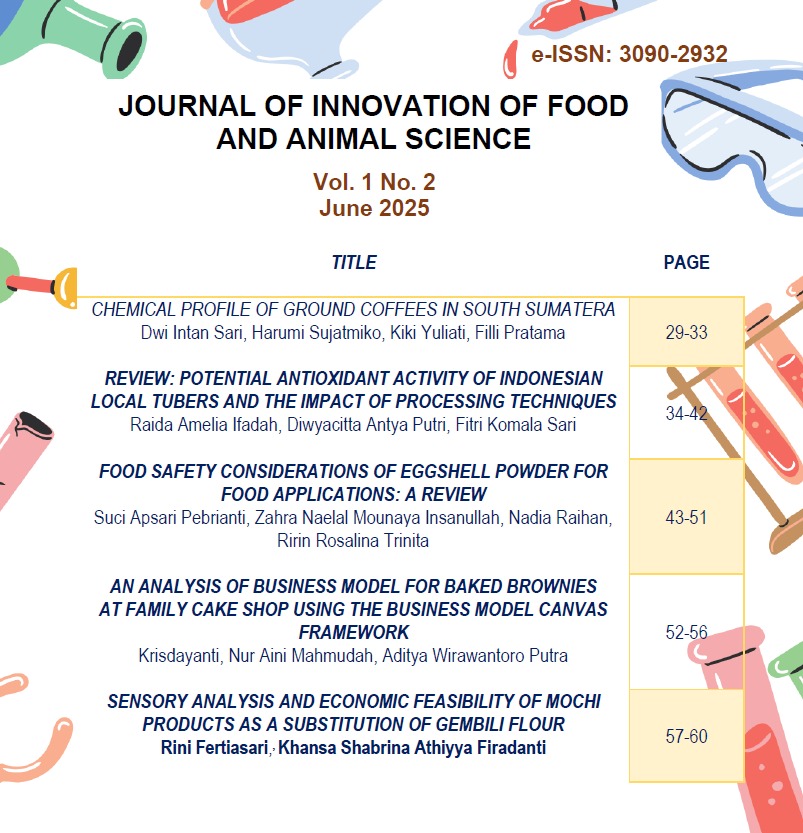SENSORY ANALYSIS OF MOCHI PRODUCT WITH SUBSTITUTION OF LESSER YAM FLOUR (Dioscorea esculenta)
 Abstract views: 182
,
Abstract views: 182
,
 PDF downloads: 139
PDF downloads: 139
Abstract
The growing demand for healthy and innovative foods has encouraged the development of traditional products using functional ingredients. This study aimed to develop mochi with lesser yam (Dioscorea esculenta) flour substitution and natural beetroot coloring as a novel healthy snack alternative. Mochi was produced by substituting white glutinous rice flour with varying levels of lesser yam flour (F1: 20 g, F2: 40 g, F3: 60 g) and incorporating beetroot extract as a natural dye. Sensory evaluation was conducted on color, taste, aroma, texture, and overall acceptability using a hedonic scale. The results showed that formulation F1 (20 g lesser yam flour) achieved the highest overall acceptability score (4.11), indicating a “like” level among panelists. F1 also received superior ratings for taste (4.06) and texture (3.97) compared to F2 and F3, which showed decreased preference as the substitution level increased. Higher concentrations of lesser yam flour contributed to a slightly bitter taste due to diosgenin content and a firmer texture from reduced amylopectin levels. This study suggests that mochi with lesser yam flour substitution and natural beetroot coloring can be a potential functional food innovation with good market prospects.
References
Estiasih, T., Mar’atirrosyida. 2014. Aktivitas Antioksidan Senyawa Bioaktif Umbi-Umbian Lokal Inferior. Jurnal Pangan dan Agroindustri, 3(2), 594-601.
Fauzi, I., Nauli, R., Hidayatuloh, S., Hutami, R. 2015. Pembuatan Mochi Pelangi dengan Subsitutsi Tepung Talas dan Pewarna Alami. Jurnal Agroindustri Halal 1(2), 107-111.
Ikbal, M., Mude, A.H., Gadisha, S.B., Pradana, A.P. 2019. Effect of Addition of White Glutinous Rice Starch (Oryza Sativa L Var. Glutinosa) In Alginate Impression Materials To Dimensional Stability. Makassar Dent Journal, 8(2), 112-117
Imzalfida, M., Indrawati, V. 2016. Pengaruh Substitusi Tepung Gembili (Dioscorea ssculenta Linn) Terhadap Sifat Organoleptik Chiffon Cake. E-Jounal Boga, 5 (1), 54-62.
Manobharati, V., Minuralini, S. 2020. Pharmacological characteristics of a phyto steroidal food saponin: Diosgenin. African Journal of Biological Sciences, 2(2), 77-87.
Mustofa, A., Pratiwi, L.D., Widanti, Y.A. 2023. Aktifitas Antioksidan Kue Mochi dengan Penambahan Ekstrak Beras Ketan Hitam, Ubi Jalar Ungu dan Buah Bit. Jurnal Teknologi Hasil Pertanian. 16(1), 75-83. https://doi.org/10.20961/jthp.v16i1.60407
Negara, J.K., Sio, A.K., Rifkhan, R., Arifin, M., Oktaviana, A.Y., Wihansah, R.R.S., Yusuf, M. 2017. Aspek mikrobiologis, serta Sensori (Rasa, Warna,Tekstur, Aroma) pada Dua Bentuk Penyajian Keju yang Berbeda. Jurnal Ilmu Produksi dan Teknologi Hasil Peternakan, 4(2), 286-290.
Prabowo, A.Y., Estiasih, T., Purwantiningrum, I. 2014. Gembili (Dioscorea esculenta L.) as Food Contain Bioactive Compounds: A Review. Jurnal Pangan dan Agroindustri 2(3), 129-135.
Pratiwi, T., Affandi, D.A., Manuhara, G.J. 2016. The Application of Lesser Yam Flour (Dioscorea esculenta) as Wheat Flour Substitution in Tuna Fish (Euthynnus affinis) Nugget Filler. Jurnal Teknologi Hasil Pertanian, IX(1), 34-50.
Sulistyono, E., Marpaung, J. 2004. Catatan Penelitian Studi Karakter Umbi dan Kandungan Nutrisi Dioscorea spp. Buletin Agronomi 32. No. 2, Bogor Agricultural University.
Wibawanto, N.R., Ananingsih, V.K., Pratiwi, R. 2014. Produksi Serbuk Pewarna Alami Bit Merah (Beta vulgaris L.) dengan Metode Oven Drying. Prosiding SNST ke-5, Fakultas Teknik Universitas Wahid Hasyim Semarang.



